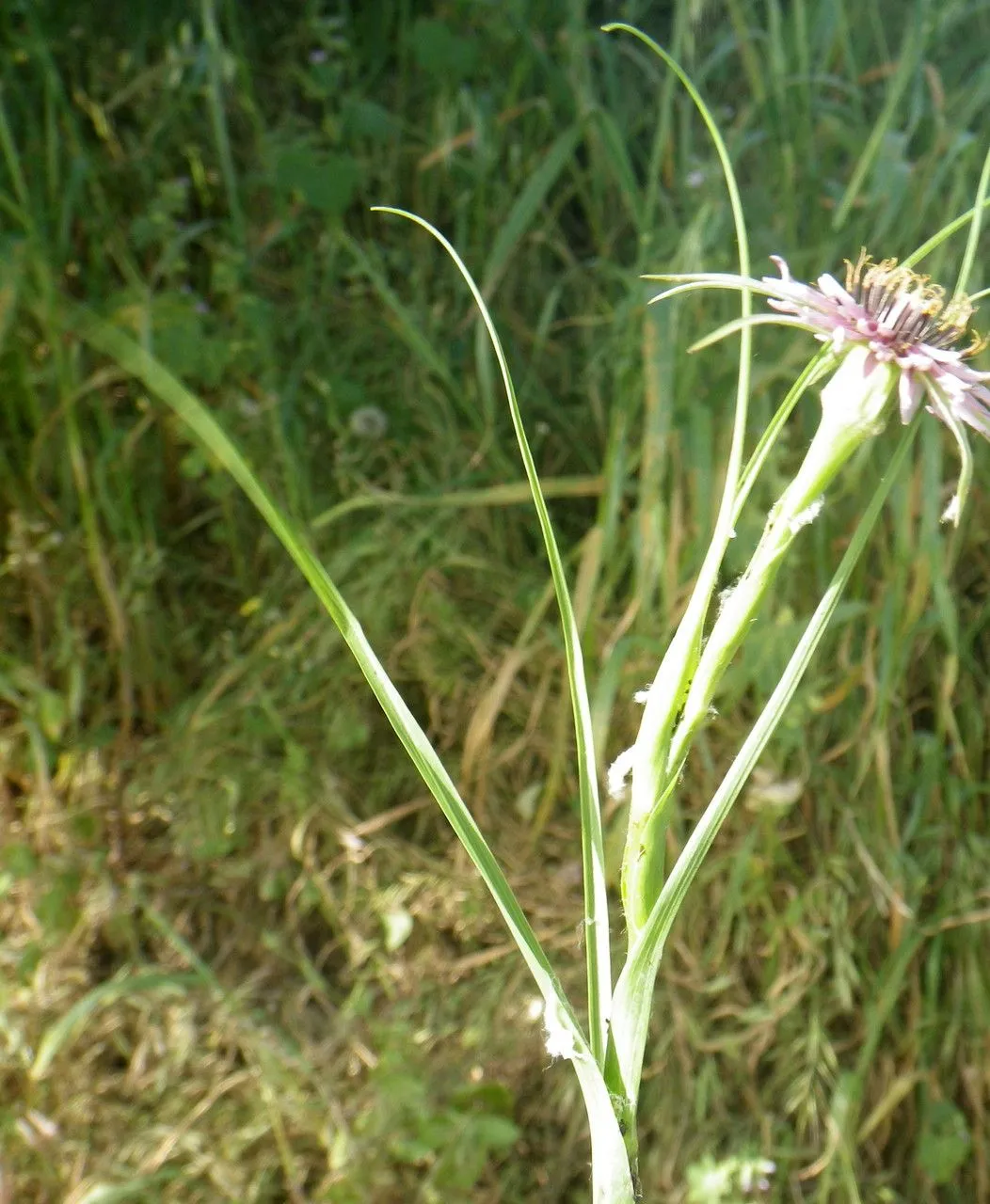
Author: (L.) Sch.Bip.
Bibliography: P.B.Webb & S.Berthelot, Hist. Nat. Iles Canaries 2: 472 (1850)
Year: 1850
Status: accepted
Rank: species
Genus: Geropogon
Vegetable: False
Observations: Macaronesia, W. Europe to Medit. and Iran
Slender salsify, scientifically known as Geropogon hybridus, is a fascinating plant that belongs to the Asteraceae family. First described by P.B. Webb and S. Berthelot in 1850 in their work “Hist. Nat. Iles Canaries,” and later classified by (L.) Sch.Bip., this plant has since captured the interest of botanists and plant enthusiasts alike.
Primarily found in regions ranging from Macaronesia and Western Europe to the Mediterranean and Iran, slender salsify exemplifies a wide climatic adaptability. It thrives in various environments, showcasing its resilience and versatility. Its presence in these geographically diverse regions speaks to its robust nature and ease of establishment once introduced to suitable habitats.
Characterized by its slender, delicate stems and vibrant flower heads, Geropogon hybridus embodies the daintiness typical of many members of the Asteraceae family. The plant often grows in open fields and grasslands, where it can receive ample sunlight and moderate water. Its flowering season brings a proliferation of blooms that contribute not only to the natural beauty of its surroundings but also play a role in local ecosystems, supporting pollinators and other wildlife.
Slender salsify is noted for its ecological and aesthetic value, often becoming a point of interest for those studying plant distribution and adaptation across different terrains and climates. Despite its inconspicuous appearance, this plant provides key insights into the environmental dynamics and biodiversity of the regions it inhabits.
In summary, Geropogon hybridus, or slender salsify, is a remarkable plant whose distribution from Macaronesia to Iran highlights its ecological significance and adaptability. Whether viewed through the lens of scientific study or admired for its simple beauty, this member of the Asteraceae family continues to hold an understated yet pivotal place in the natural world.
Ita: barba di becco annua
Spa: barba macho
Sqi: lulebrigje hibride
Fra: salsifis glabre, salsifis hybride
Deu: schlanker bocksbart
Eng: slender salsify
Swe: späd haverrot
Heb: זְקַן-סָב מָצוּי, זקן-סב מצוי
Ara: سَلْسَفيل هَجين
En: Slender Salsify, Hybrid Goat’s-beard
Sq: Lulebrigje hibride
Ar: سَلْسَفيل هَجين
Fr: Salsifis glabre, Salsifis hybride
De: Schlanker Bocksbart
He: זְקַן-סָב מָצוּי, זקן-סב מצוי
It: Barba di Becco annua, Barba-di-becco annua
Es: Barba macho
Sv: Späd haverrot
: Pasture goatsbeard
Taken Apr 28, 2013 by Tela Botanica − Geneviève Botti (cc-by-sa)
Taken Apr 14, 2021 by Lucia Sanchez (cc-by-sa)
Taken May 9, 2021 by Laurence Penco (cc-by-sa)
Taken Jun 11, 2022 by Annemarie Ahrens-Stehle (cc-by-sa)
Taken Aug 25, 2022 by decebal bora (cc-by-sa)
Taken Apr 19, 2018 by Tela Botanica − Liliane Roubaudi (cc-by-sa)
Taken Apr 19, 2018 by Tela Botanica − Liliane Roubaudi (cc-by-sa)
Taken May 2, 2013 by Tela Botanica − Liliane Roubaudi (cc-by-sa)
Taken May 2, 2013 by Tela Botanica − Liliane Roubaudi (cc-by-sa)
Taken May 2, 2013 by Tela Botanica − Liliane Roubaudi (cc-by-sa)
Taken May 30, 2022 by Monteiro Henrique (cc-by-sa)
Taken Apr 15, 2009 by Photoflora – Benoit BOCK (©)
Taken Apr 15, 2009 by Photoflora – Benoit BOCK (©)
Taken May 29, 2021 by Zaro Luca (cc-by-sa)
Taken Apr 15, 2006 by Photoflora – Benoit BOCK (©)
Taken Apr 19, 2019 by L M (cc-by-sa)
Taken Apr 15, 2006 by Photoflora – Benoit BOCK (©)
Taken May 4, 2019 by L M (cc-by-sa)
Taken May 3, 2020 by Torres Pedro (cc-by-sa)
Taken May 3, 2020 by Torres Pedro (cc-by-sa)
Taken May 3, 2020 by marco bito (cc-by-sa)
Taken May 20, 2020 by Inna2208 Inna2208 (cc-by-sa)
Taken Apr 10, 2020 by Inna2208 Inna2208 (cc-by-sa)
Taken Apr 15, 2006 by Photoflora – Benoit BOCK (©)
Taken Apr 15, 2006 by Photoflora – Benoit BOCK (©)
Taken Apr 15, 2009 by Photoflora – Benoit BOCK (©)
Taken May 15, 2017 by Photoflora – Benoit BOCK (©)
Taken Jan 1, 1970 by Photoflora – L’Abbé COSTE (©)
© copyright of the Board of Trustees of the Royal Botanic Gardens, Kew.
© copyright of the Board of Trustees of the Royal Botanic Gardens, Kew.
© copyright of the Board of Trustees of the Royal Botanic Gardens, Kew.
Ph maximum: 7.0
Ph minimum: 6.5
Light: 8
Atmospheric humidity: 4
Bloom months: [‘may’]
Soil nutriments: 7
Family: Myrtaceae Author: (F.Muell.) K.D.Hill & L.A.S.Johnson Bibliography: Telopea 6: 402 (1995) Year: 1995 Status:…
Family: Rubiaceae Author: Pierre ex A.Froehner Bibliography: Notizbl. Bot. Gart. Berlin-Dahlem 1: 237 (1897) Year:…
Family: Sapindaceae Author: Koidz. Bibliography: J. Coll. Sci. Imp. Univ. Tokyo 32(1): 38 (1911) Year:…
Family: Asteraceae Author: A.Gray Bibliography: Pacif. Railr. Rep.: 107 (1857) Year: 1857 Status: accepted Rank:…
Family: Fabaceae Author: Medik. Bibliography: Vorles. Churpfälz. Phys.-Ökon. Ges. 2: 398 (1787) Year: 1787 Status:…
Family: Aspleniaceae Author: (Cav.) Alston Bibliography: Bull. Misc. Inform. Kew 1932: 309 (1932) Year: 1932…